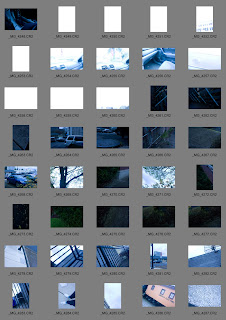Tuesday, April 26, 2011
Monday, April 25, 2011
Rules
1. A photograph is taken whenever I feel the desire to photograph something.
2. The angle of the photograph is determined by the way in which a ball lands with a pre-marked axis consisting of a dot indicative of the optical axis.
3. The exposure of the camera is set by using two die: one for the shutter speed and one for the aperture.
4. The focus is set by a die marking the focal plane in feet from the camera.
5. The height at which the camera shoots is determined by asking any person unaware of the purpose of the answer to provide me with a number. If that number is higher than I can reach or lower than the current ground plane, I must immediately adjust to get as close to that height (in feet) that I can. Once the height is reached rule 2-5 are put into effect.
Monday, April 18, 2011
Tuesday, March 29, 2011

Peter Campus. Shadow Projection, 1974, video installation. Courtesy Paula Cooper Gallery.
Peter Campus
Body Projection 1974
In this work by Peter Campus, the viewer walks in front of a screen that has been washed out by a light shining behind the viewer. As a result of the backlight, the viewer can see their shadow or silhouette in the screen. Next to the light casting the shadow, is a closed circuit camera, projecting the real time image on the other side of the screen. A remarkable installation is created by the layering of the actual silhouette with the addition of the camera of the back of the viewer. A dramatic separation exists in the space between the video of the viewer and the shadow they cast. Two polarized strategies of representation exist using the addition/subtraction of light and projected light. Both representations are no more “realistic” or “truthful” than the other, as the camera continually provides falsified information we begin to rely on. What is our shadow but a product of the light sources? What is a video of us but the product of the camera?
I am interested in creating installations that challenge our inherited perceptions of viewing and perception of “time” and “space”. One can argue that these installations overlap a variety of media disciplines and approaches to artistic practice. I have arrived at a place where a pure photographic representation does not exist, and I must comment on that by performing a separation from the medium to better understand it. The sculptural elements of installation work also interest me. For example, physical reactions to objects as a different form of the “referent”, along with the manipulation of physical “space” which can occur.
Sontag, Susan. On Photography. New York, NY: Farrar, Straus and Griroux, 1977. Print.
“Photographs furnish evidence. Something we hear about, but doubt, seems proven when we’re shown a photograph of it…A photograph passes for incontrovertible proof that a given thing happened. The picture may distort; but there is always a presumption that something exists, or did exist, which is like what’s in the picture. Whatever the limitations (through amateurism) or pretensions (through artistry) or the individual photographer, a photograph-any photograph- seems to have a more innocent, and therefore more accurate, relation to visible reality than do other mimetic objects” (6).
The photograph has long been used as a tool for recording and providing evidence of an action by capturing information during an event or photographing the residue of an activity or individual. The photograph operates as a record-keeping device believed to preserve the integrity of a first hand account long after the event or witnesses have ceased to exist. Despite this role the photograph has come to play in our sense of accurate recording, the photograph is a records nothing more than the light that is in front of it. The photograph holds no truth as it is a simply a reflecting device, only able to refer to what is put before the lens. In this way, “evidence” as it is conceived of in our society can be easily fabricated or altered. I use this power the photograph holds to my advantage, utilizing our trusting relationship with photographic proof. I create scenes to be photographed, which someone could consider to be false representations or constructed scenarios, and they are indeed. But I aim to question the validity of any photograph through the tension of fantasy and believability I present.
Subscribe to:
Comments (Atom)









